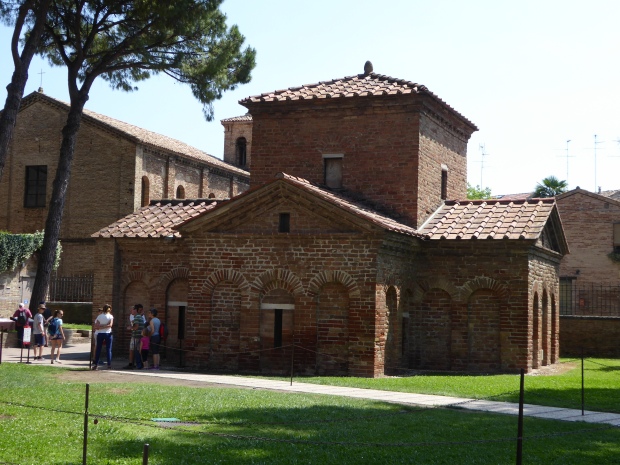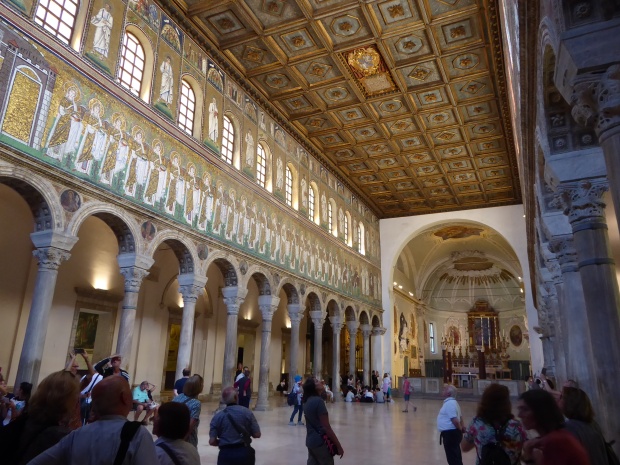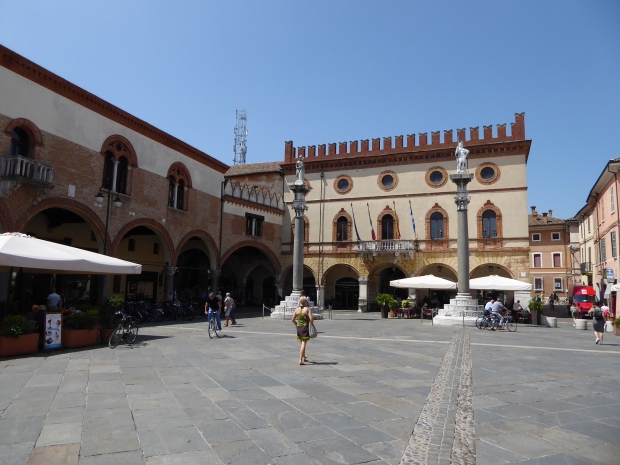From our stay in Ferrara (Italy) we moved on to Ravenna, about 87 km (54 miles) southeast, near the Adriatic Sea and not too far south of Venice. Ravenna has been on my bucket list for a long time. It has a glorious history as the capital of the western of Roman Empire between the fall of Rome (5th century CE) and the rise of Byzantine Empire in Constantinople (Istanbul). The main tourist sights are the beautiful early Christian mosaics found in the churches and baptistries from the 5th – 6th centuries, amazingly still intact. They are incredible!
Shown below are most of most main sights to see in Ravenna.
Basilica di San Vitale
This church is probably the most stunning of all the locations. The mosaics date from 526 – 547 CE, and look like they were finished yesterday.

Exterior of the Basilica di San Vitale, which may have been designed by someone from Constantinople.

The apse of San Vitale – perhaps the most stunning mosaics in all of Ravenna. One has to just stand there in awe and absorb all the detailed work that went into creating these murals.

A close-up of the mosaics in San Vitale, showing stories from the Old Testament of Abel and Melchizedek making offerings.
Mausoleo di Galla Placidia
Right next to San Vitale is the Mausoleo di Galla Placidia. Despite its name, this structure became a private chapel rather than a tomb. The Mausoleo was begun in 430 CE.

Exterior view of the Mausoleo di Galla Placidia.

Interior view of the Mausoleo. The alabaster windows were an early 20th century gift from the King of Italy.

One other view of the interior of the Mausoleo di Galla Placidia.
Battistero Neoniano (Neonian Baptistry)
This is Ravenna’s oldest monument, from the early part of the 5th century CE. It is located next to Ravenna’s Duomo (cathedral) and the very cool 10th century leaning bell tower.

The Neoniano Baptistry is on the right, the leaning 10th century bell tower is in the background and the Duomo on the left.

Interior of the Battistero Neoniano, showing the baptism of Jesus in the ceiling of the dome.

Although not part of the historical tour ticket, this is an interior view of Ravenna’s Duomo, located next to the Battistero Neoniano. The Duomo has been rebuilt over the centuries, the current structure dates from the 18th century.
Sant’ Apollinare Nuovo
This is a 6th century CE church, named for the first bishop of Ravenna, and it has a bit different feel to it than the other monuments above (rectangular, lighter and more open). It was constructed by Theodoric the Great, as his palace chapel. It is also included as part of the combination ticket. There are mosaics of scenes from Christ’s birth, his miracles and resurrection as well as representations of numerous saints and martyrs in this church.

Exterior view of Sant’ Apollinare Nuovo church (6th century CE).

Interior view of Sant’ Apollinare Church. On the left lower panel is a procession of 22 virgins traveling towards the Madonna and Child (located near the apse).

This image captures part of the succession of martyrs (lower panel), opposite from the procession of the virgins. The structure to the right of the martyrs represents the Palace of Theodoric.
To visit the main sights above, go to the tourist office in the old town, and purchase a ticket (€11.50 at the time of our visit) and a map of the sights included.

This sign, at one of the main sights, shows the places included in the combination ticket.
The streets are also pretty well marked, with arrows pointing and providing directions towards the main churches.

Example of a street sign providing directions to the sights.
Keep in mind that you will be walking quite a bit, although the points of interest are not too far apart and can be easily visited in 2/3 of a day. During our visit in May, the sights were not crowded, there were no lines to enter any of the churches. However, later in the summer, it will likely be quite a bit busier, we saw ropes to handle long lines at least at a couple of the more popular locations.
In addition to the sights above, there are some other places you should see in Ravenna.
Battistero degli Ariani
I’m not sure why this little late-5th century CE baptistry is not part of the ticket above, but it’s worth taking a look. I think it cost €1 to visit. It is located a few blocks from Sant’ Apollinare Nuovo.

Exterior of Battistero degli Ariani.

The cupola of the Battistero degli Ariani, showing the Apostles ringed around baptism of Christ.
Basilica di San Francesco and Dante’s Tomb
The Italian poet Dante died in Ravenna in 1321, and his tomb is just to the side of the Basilica di San Francesco, which is also worth a visit for its flooded crypt.

Exterior view of the Basilica of San Francesco. Dante’s tomb is on the left side, out of view of this photo. The church was built between the 9th and 10th centuries CE, and then underwent modifications a couple hundred years later.

The flooded 10th century crypt (complete with gold fish) in the Basilica di San Francesco. You pay 1 euro to have the crypt illuminated. The marshy land and high water table in Ravenna has kept the crypt flooded for centuries.

Exterior of Dante’s tomb.

Interior of Dante’s tomb, he was 56 years old when he died.
San Giovanni Evangelista
This church, close to Sant’ Apollinare Nuovo was rebuilt over the centuries, and has some very interesting fragments of old mosaics along its aisles.

Interior of San Giovanni Evangelista, which looks similar to Sant’ Apollinare Nuovo.

Examples of the mosaic fragments in San Giovanni Evangelista.
Everywhere you turn in Ravenna, there is something interesting to see…

An old Roman building on a street corner in Ravenna.
The old town has a pleasant main square, with restaurants surrounding it.

Ravenna’s main square, Piazza del Popolo.

Ravenna street scene. In the afternoon, the streets are pretty quiet, until the residents come out for their evening stroll.
We stayed in a lovely B&B just south of the old town, perhaps a 1/3 mile walk to the center of the old town.
